|
The Lyman .44 Devastator hollow point
(#429640) was clearly designed with the .44 Magnum in mind, and it serves this
cartridge very well indeed. It can be driven 1300-1400 fps from good, strong
hunting revolvers, and has proven to be very accurate in my guns. I used the .44
Devastator HP to take a mule deer over in the basalt-lined canyons of the Snake
River in eastern Washington a few years ago and was very pleased with its
performance. I know of other hunters who have used the .44 Devastator
hollow-point (HP) to take deer, feral hogs and even bison, all with favorable
results. The bottom-line is that the .44 Devastator is a fine hunting bullet in
the .44 Magnum.
Recently, a friend of mine asked me how the
.44 Devastator shot in the .44 Special, and I had to confess that I didn’t know.
Years ago, I had done some experiments using heavier than normal solid
bullets (275-300 grain) in the .44 Special. While these experiments yielded good
accuracy, there was nothing in the overall ballistics to convince me to move
away from the 250 grain Keith SWC for my everyday routine .44 Special load (10.0
grains of HS-6 for 900-1000 fps, depending on barrel length). But a soft, heavy
HP for the .44 Special at ~1000 fps could be a very useful load, especially with
the gaping HP cavity that Lyman put on the .44 Devastator that is sure to induce
expansion at moderate velocities. Cast with the appropriate alloy (a BHN of
around 8 should be about right), this could be a very effective hunting
combination for deer-sized game animals. My friend’s curiosity led me to dig out
my old loading data, and then fire up my lead pot for another .44 Special
project (oh boy!).
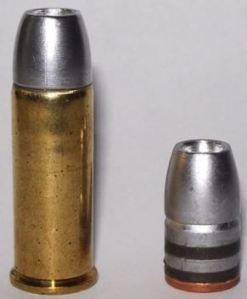 |
|
.44
Special and Devastator HP. |
I would like to emphasize that the idea behind
these loads is not to red-line the .44 Special cartridge and extract “maximum
performance” from it, but rather to combine the features of the Devastator HP
with the .44 Special cartridge to create a moderate velocity hunting load
capable of extracting reliable expansion from the Devastator HP. I suspect that
such a combination should be an accurate, reliable and highly effective hunting
load.
Safety disclaimer:
I have not measured the pressures generated by these loads. I would estimate
that they are operating in the 20-25,000 psi range, but I do not know that for
sure. These loads were safe in my guns, and I believe them to be safe in any
large-framed .44 (either Special or Magnum). These Devastator loads are not
suitable for any of the smaller .44 Specials (e.g. Charter Arms Bulldog,
Taurus 431, S&W 696, etc.).
For intermediate pressure loads like this
(i.e. in between standard pressure handgun loads at ~16,000 psi and magnum
pressure handgun loads at ~35,000 psi) I like to use powders with intermediate
burn rates in between Unique and 2400. There are a number of fine powders in
this burn rate range, but two of my favorites are HS-6 and Accurate Arms #7, so
that’s where I started. Based on my previous work with heavier than normal cast
bullets in the .44 Special, I chose to look at two powder charges – 10.0 grains
of HS-6, and 11.5 grains of AA #7. Neither of these powders requires the use of
magnum primers, so standard primers were used throughout (CCI 300s). These
429640 HP’s were cast with recovered range scrap, with a measured BHN of about
8. They were sized .430” and lubed with my homemade Moly lube (50/50
beeswax/Moly grease). Hornady crimp-on GC’s were used. Bullets dropped from the
blocks at 262 grains, and weighed 270 grains after being checked and lubed. A
heavy roll crimp was used for all loads.
 |
|
The Ewer
7 ½” .44 Special Blackhawk. |
|
|
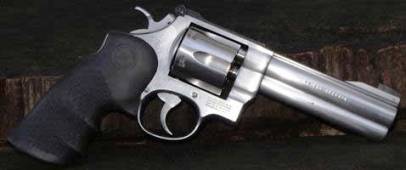 |
|
The Ewer
5” 624 .44 Special. |
Test guns for this were two revolvers with
proven track records of excellent accuracy -- a 7 1/2" stainless Ruger Blackhawk
.44 Special built by my good friend Dave Ewer (that is superbly accurate), and a
S&W 624 fitted with a 5” full-lug barrel (also put together by Dave, and also
very accurate).
Both of the .44 Special Devastator HP loads
delivered very good accuracy, with 10-shot groups at 50 feet averaging right at
1 ¼”. Several groups were 1 1/8”, and the largest was 1 7/8” (due to a flyer
that I pulled low/left, the other 9 went into under 1 ½”). In my guns, the HS-6
load appears to be slightly more accurate than the AA #7 load, but the
difference is small enough that it can be ignored. Both loads chronographed
right at 1015 fps from the 7 ½” Ruger .44 Special. No surprise here, but with a
gas-checked cast bullet at 1000 fps with a good lube, there was zero leading
observed, and the bore was left shiny clean.
I have not done any expansion testing with the
Devastator HP yet at these speeds, but previous experience has shown that
traditional HP’s expand reliably when cast to this hardness and fired in this
velocity range. I have no doubt that the .44 Devastator, with its gaping maw up
front, will provide positive expansion when cast to a BHN of about 8, and fired
at about 1000 fps. This combination should make a good short-range deer load.
One other application for the .44 Special
Devastator load would be in a .44 lever-gun. When loaded into .44 Magnum cases,
the .44 Devastator HP is just barely short enough to cycle in my Marlin 1894
(i.e. the OAL is just barely short enough). However, the mouth of the Devastator
HP is fragile enough that at this OAL the mouth gets dinged by the upper edge of
the breech/chamber, and prevents smooth chambering of the round. With the
shorter OAL of the .44 Special Devastator, these loads feed smooth as butter in
my Marlin. I would expect these .44 Special Devastator loads to generate 1200+
fps from the lever-gun, making them excellent hunting loads for deer-sized game
(especially for the recoil conscious).
Lightweight cast HP’s
As long as I was playing with new
cast HP’s in the .44 Special, I was also interested in working up some cast HP
loads for my 3” S&W 696. Loads for this gun need to be kept to 18,000 psi peak
pressure or less, so the +P loads described above are not suitable for this
little gun. Previously, I have worked with a variety of lighter cast bullets
(175-200 grains) and gotten some good results with some (but not all) of these
bullets. The lighter weight allows them to be pushed to higher velocities, while
still staying within standard pressure guidelines. These higher velocities can
be very useful with cast HP’s.
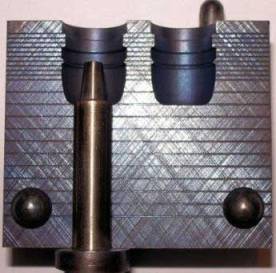 |
|
Modified
RCBS 44-200-CM mould. |
| |
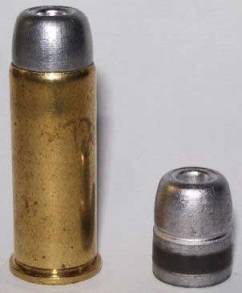 |
|
188 HP
loaded into the .44 Special. |
|
A while back, I bought a mould from Erik Ohlen
(http://www.hollowpointmold.com/,
erik@hollowpointmold.com, (541) 738-2479) that he had modified, starting
with an RCBS Cowboy mould (44-200-CM). One cavity was left as it was, and the
second cavity was converted to drop HP bullets. Erik included several different
pins so I could play around with different HP configurations (large HP, small
HP, cone point, etc.). For this project, I chose to go with one of the larger HP
cavities (.185” in diameter, .280” deep, tapered to a flat-bottomed cavity).
Cast with recovered range scrap (BHN ~8), these HP’s dropped from the blocks at
188 grains (the un-altered cavity drops bullets of 203 grains when cast with
this same alloy, so the HP pin “removed” approximately 15 grains of bullet metal
to make the HP cavity). They were sized .430” and lubed with my home-made Moly
lube.
I have gotten some very good results
with lightweight cast bullets in the .44 Special using Unique (see “The .44
Special Revisited”), so that’s where I started. The Lyman loading manual reports
that 8.2 grains of Unique with 205 grain cast bullets (Lyman 42798) generates
870 fps at a peak pressure of 14,000 CUP, and the Hodgdon manual reports that
9.2 grains of Unique underneath a 180 grain JHP generates 1000 fps with a peak
pressure of 13,400 CUP. Therefore I decided to use 8.7 grains of Unique for the
188 grain RCBS Cowboy HP to stay at this same pressure level. Accuracy testing
with the 188 grain RCBS Cowboy HP consistently produced 10-shot groups at 50
feet of 3” from the 3” S&W 696, when this bullet was sized .430”. This revolver
will not allow a bullet sized .430” to pass through any of the throats, so tests
were repeated with .429” bullets. These tests produced noticeably better
results, with 5-shot groups running 2-2 ½”. This is considerably better than was
obtained with some of the other lightweight cast bullets (8-12”), but not as
good as the best loads I’ve run through it to date (1 ½” for 5 shots).
Chronographing this combination from the 3” S&W 696 revealed an average velocity
of 1035 fps, easily fast enough to make this big-mouthed HP expand reliably when
it’s cast nice and soft. The RCBS 44-200-CM clearly has promise for use in the
snubby.
Tests in the other guns were also enlightening. The 5” S&W 624 (with its .431”
factory throats) also didn’t do very well with the 188 HP, grouping 6 of 10 into
1 hole and spraying the other 4 all over the target (bullets were sized .430”).
However,
| |
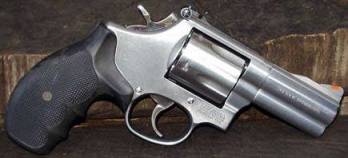 |
|
The S&W
696. |
the custom Ewer .44 Special stainless
Blackhawk (with its uniform .430” throats) was a different story altogether – 10
shots into one ragged hole at 50 feet! This bullet clearly has potential to be a
dynamite varmint load, and I just need to tailor the loads to fit whatever
revolver I’m going to be shooting them in. I didn’t chronograph this 188 grain
HP load in the 7 ½” Blackhawk, but I would anticipate that this load is
generating 1150-1200 fps.
The .44 Special has been traditionally viewed
as being best served by 240-250 grain bullets. There is no doubt that there are
a bunch of very useful .44 Special loads that use 240-250 grain cast bullets,
but there are also some very useful, albeit somewhat more specialized, loads
that can be assembled with cast bullets falling outside of this traditional
weight range. The 270 grain Devastator HP and the 188 grain cowboy mould HP
provide some very interesting examples of how the .44 Special can be well-served
with non-traditional weight cast HP’s.
-
Glen E. Fryxell
|